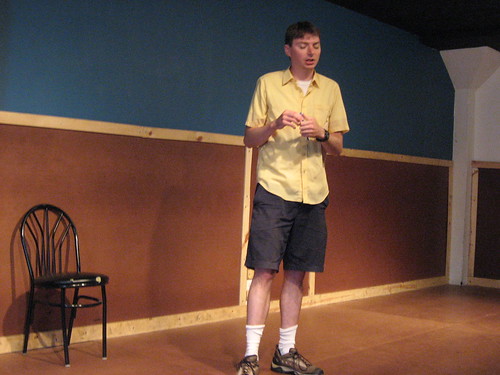
New week. New level. New teacher. Introducing Pat O'Brien, a director at Second City and a member of the young "team to watch" at iO, The Reckoning.
First, I gotta say, it's been great to have teachers that actually do improv, regularly, and well. The Reckoning is that cool young team that everyone's talking about. They do two shows a week. One is a straight Harold format. The other is them experimenting with all kinds of form. I saw one show, referred to as a Bat, where they did the whole show in the dark. No physical movement was involved, just speaking and some sound effects from random crap they brought onstage. It reminded me of old radio shows my mom loved.
The purpose of week 4 is to really learn The Harold, that infamous, all-encompasing, truth-seeking, and very challenging structure pioneered by Del Close himself.
Harold Diagnostic
Pat began class by splitting us into two groups of seven and eight, respectively. Each group did a full Harold based on what we'd learned already, and he offered a boatload of feedback, criticisms and ideas. As it would become clearer over the course of the week, one of Pat's strengths is in showing us the possibilities for any given show or scene. He helped us think about the connections we didn't pick up on that could make a show much better. Given the amount of information one must keep track of in a Harold, he also shared a simple but infinitely valuable tip:
Keep it fun, and focus on one aspect of the Harold at a time.
For example, in one show you might decide that you're gonna focus on editing. In another, you focus on playing emotionally. Etc. etc.
His advice after watching our first two Harolds included:
- A piece needs more than one game. There should be several games in a show that weave in themes from the opening left out of the scenes so far, for example
- Tag-ins to a scene don't have to assume the same physicality as the person they tagged out
- As always, LISTEN, especially to the games because they might have plot or character direction in them. In our case the example was a game based on "Extra Extra. Read All About It" headlines, one of which referred to a Broadway dancer taking the theatre world by storm. That was referring to a scene about a Broadway dancer, so when that scene came back, it should have acknowledged the dancer's success
- Time dashes from Beat 1 scenes to Beat 2 scenes can also dash backward in time. It's rarely done but very cool
- The very first scene after the opening can work well by beginning with a noise or movement from the opening itself
- In a fade edit (where one scene starts in a different place on the stage while another is underway), avoid eye contact with the existing scene so as not to confuse those players who might think you're a walk on into their scene. Simply stand a bit downstage of them and begin your scene as you walk in
- Go for stage picture balance. If a player from the side decides to play a piece of furniture in a scene, don't leave them to do it all alone. Someone else should play a different piece to support the move
- It can be very difficult to do a scene where it's made clear from the start that the characters don't know each other. Pick people with an existing relationship
- Beat 3 doesn't have to connect all the characters from the previous scenes, but it can connect all the themes
The Opening
After ripping our Harolds a new one, Pat started to break down the structure piece by piece. We began with the Opening.
The purpose of the opening is to generate information from the suggestion that can be used to create scenes. It helps develop that beautiful "group mind" among the players and can inform the audience about the "Rule of Three" implicit in the Harold itself. The opening can be a microcosm of the entire piece.
EXERCISE: "I AM"
The "I Am" exercise starts when one person steps forward and says something like, "I am a yellow toothbrush."
Another player enters, adding, "I am the chocolate residue on the bristles.
Another adds, "I am the Flintstones logo on the toothbrush."
"I am the mold building up on the handle."
"I am the the piece of the toothbrush that broke off and fell onto the floor three months ago."
Each time a player adds information about this object, he takes on (to the extent possible) the physicality of that which he tries to embody. In the end, the audience sees this richly-defined toothbrush with a full story behind it.
The next phase of the exercise is to construct three complete objects as the opening itself. Use the objects to discover characters and themes. For example. in the case of the above toothbrush, we might have a child who eats too much junk food and lives a horribly filthy life.
The next object in the opening could be the family car, complete with old M&Ms stick to the seats and the smell of wet dog permeating the interior.
The final object might be the desk of this kids father, with papers wholly disorganized, notes taped every which way and five long-finished mugs of coffee.
These three objects may set the stage for a Harold about filth, disorganization, disease, etc. Perhaps one set of scenes is about how children adopt the behaviors of their parents. I don't know. I've made this all up, but the point is that an opening based around constructing detailed objects can reveal the characters and themes necessary to build a quality Harold.
Some reminders about object-oriented openings:
- Focus on one object at a time, and stick with it. In the midst of building and describing this toothbrush, don't start talking about the sink or the mirror. Keep it focused on the initial object
- Consciously try to discover themes and characters. If the first two objects have a theme of joy, so should the third.
- Don't go overboard exploring too many themes. Ideally, the Harold opening should finish with one very clear theme for the show, maybe two. But an opening with four themes is not a true opening. It's a grab bag of possibilities that leaves the Harold itself open to too many paths of discovery
- Try to mirror the vocal style of each objects description. For example, if I initiate an object with, "I'M THE AMERICAN CONSTITUTION!!" and I say it all patriotic and bubbly with a nice salute to an imaginary flag, then the person that follows should adopt that same level of enthusiasm.
- Try to create beautiful stage pictures
- Raise the energy as you approach the end of the opening
- Focus
- Focus
- Focus
